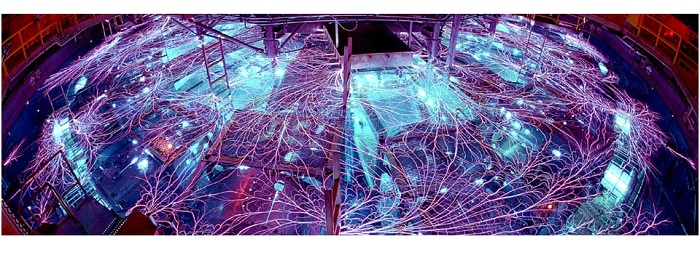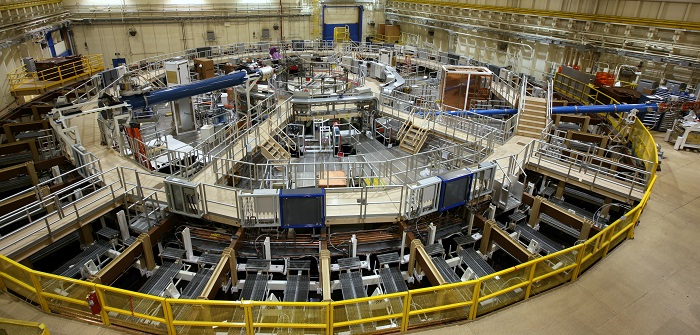An accelerator called “Thor” is being created at Sandia National Laboratories. When it’s completed, it’ll be about 40 times more efficient than the Lab’s Z machine, which is presently considered the world’s most powerful pulsed-power accelerator.
The purpose of these tools is to generate pressure to see how materials respond under extreme conditions. Just how much pressure? Millions of atmospheres worth.
 “Thor's magnetic field will reach about one million atmospheres, about the pressures at Earth's core,” said David Reisman, lead theoretical physicist of the project.
“Thor's magnetic field will reach about one million atmospheres, about the pressures at Earth's core,” said David Reisman, lead theoretical physicist of the project.
Now, for anyone familiar with accelerators, it’s worth pointing out that the Z machine generates roughly 5 million atmospheres of pressure. So, while Thor might fall short in that regard, what’s exciting about it is the size of it — this new accelerator is just 2,000 square feet, which is significantly smaller than Z’s 10,000 square feet footprint. Thor will also be much more efficient due to various design improvements, most notably its use of hundreds of small capacitors to generate pressure, rather than a few big ones like with Z.

The Sandia team was able to pull off this massive change to the accelerator thanks to a transformation of computer architecture; specifically, as opposed to using a single, extremely powerful computer chip, the group used many simple chips that worked in unison. Also, the several high-voltage vacuum tubes used in the Z were replaced with computers powered by a higher quantity of low-voltage, solid-state switches.
Another point about the improved efficiency of Thor over Z: the large capacitors used for the latter accelerator required larger switches to shorten the machine’s electrical pulse from a microsecond to 100 nanoseconds. Thor, on the other hand, uses small switches that discharge current in a 100-nanosecond pulse immediately; this, in turn, eliminates the inevitable energy loss that comes with compressing a long pulse.
Altogether, this new approach to the accelerator’s architecture allows for finer control of the pulse sent to probe materials.
“Individual cables from pairs of capacitors separate our signals,” said Reisman. “By combining these signals in any manner we choose, we can tailor very precise pulses of electrical current.”
The benefit of tailored pulse shapes is that they help avoid shocks, which would otherwise force materials being investigated to change their state (thereby nullifying the actual investigation).
“We want the material to stay in its solid state as we pass it through increasing pressures,” Reisman explained. “If we shock the material, it becomes a hot liquid and doesn't give us information.”
It’s also worth pointing out that beyond being able to control each capacitor’s transit time to the nanosecond, the team is able to isolate each one from all the other capacitors, thereby allowing for some never-before-seen observations. “In 30 seconds on a computer, we can determine the shape of the pulse that will produce a desired compression curve, whereas it takes days to determine how to create the ideal pulse shape for a Z experiment,” Reisman said.
Because Thor is able to fire off so frequently (and with less hardware damage per shot than its larger counterpart), rebooting can be done more quickly, and less technicians are needed for its operation — this all leads to more opportunities being made available for the team to test out ideas.
The last thing worth mentioning — how is Thor assembled? Basically, it’s by way of several shoebox-sized units, referred to as “bricks.” Each one contains two capacitors and a switch. Everything is dependent upon being able to add bricks. Right now, Sandia is building the accelerator in stages, and already has assembled materials. Two intermediate stages are expected to be completed in 2016. These will be made up of 24 bricks (Thor 24) and 48 bricks (Thor 48).
“These are 'first-light' machines that will be used for initial experiments and validation,” Reisman said.
When completed, Thor 144 will be expected to reach one million atmospheres of pressure.
As the project has developed, the academic community has begun taking a keen interest in it; specifically, the accelerator’s distinct architecture. “Part of the motivation for Thor was to develop affordable and compact machines that could be operated at universities,” said Reisman.
Schools that have expressed interest include Cornell University, University of California San Diego, Imperial College London and the Carnegie Institution.
Advertisement
Learn more about Electronic Products Magazine





